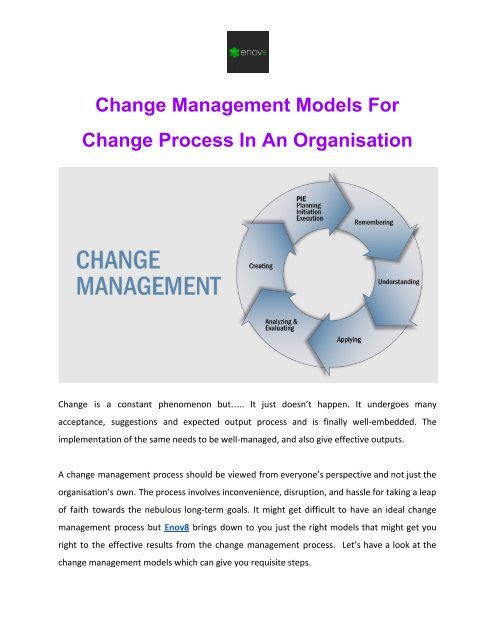Change Management Models For Change Process In An Organisation
Enov8 brings down to you just the right models that might get you right to the effective results from the change management process. Not all the models are the cherry pick, many of them depend on your team, structure, support and more. There are many IT environment management tools available through which you can breed the change in the organisation and within.
Enov8 brings down to you just the right models that might get you right to the effective results from the change management process. Not all the models are the cherry pick, many of them depend on your team, structure, support and more. There are many IT environment management tools available through which you can breed the change in the organisation and within.
You also want an ePaper? Increase the reach of your titles
YUMPU automatically turns print PDFs into web optimized ePapers that Google loves.
<strong>Change</strong> <strong>Management</strong> <strong>Models</strong> <strong>For</strong><br />
<strong>Change</strong> <strong>Process</strong> <strong>In</strong> <strong>An</strong> <strong>Organisation</strong><br />
<strong>Change</strong> is a constant phenomenon but….. It just doesn’t happen. It undergoes many<br />
acceptance, suggestions and expected output process and is finally well-embedded. The<br />
implementation of the same needs to be well-managed, and also give effective outputs.<br />
A change management process should be viewed from everyone’s perspective and not just the<br />
organisation’s own. The process involves inconvenience, disruption, and hassle for taking a leap<br />
of faith towards the nebulous long-term goals. It might get difficult to have an ideal change<br />
management process but Enov8 brings down to you just the right models that might get you<br />
right to the effective results from the change management process. Let’s have a look at the<br />
change management models which can give you requisite steps.
● Lewin’s change model:<br />
This is the oldest documented model on-going since the mid-1900s. The model was incepted by<br />
Kurt Lewin and is divided into three major steps:<br />
● Unfreeze;<br />
● <strong>Change</strong>;<br />
● Freeze<br />
The three major challenges faced by an organisation are addressed in this model. Unfreezing<br />
step aka removing restrictions for accepting changes involves analysis of current processes. You<br />
need to convince people about the changes you want to implement and win their hearts. The<br />
next step, <strong>Change</strong> involves the implementation of the same by managing the psyches of the<br />
employees and the output. The Freeze means the changes are implemented and can be<br />
crystallized for practising it for years during the IT test environment management.
● Bridges’ Transition model:<br />
Willian Bridge, an organisational consultant, through his skill of managing and understanding<br />
the human side, cracked down a model for <strong>Change</strong> management. This model runs parallel to<br />
the Lewin model and can be categorized as below:
● Endings;<br />
● Neutral zone;<br />
● New beginnings<br />
One should be ready to welcome some negative emotions through the employees. It may<br />
sound sceptical initially, but one should know that your organisation’s staff is comfortable to<br />
work in a particular environment only for years. <strong>An</strong>y changes will shake this up and the “ending<br />
zone” represents this. This negative feeling will soon settle down after proper convincing and<br />
will lead a way towards the new beginnings.<br />
The model is dedicated completely towards managing emotions and morale of the employees.
● Kotter’s 8 step change model:<br />
Developed by John Kotter, this is the only model that focuses less on change and more on the<br />
people involved. You need to an influx of the sense of urgency for the change implementation.<br />
The great effect of the model can be achieved following the below-mentioned 8 steps:<br />
1. Create a sense of urgency;<br />
2. Building a guiding coalition;<br />
3. <strong>For</strong>m a strategic vision and initiatives;<br />
4. Enlist a volunteer army;
5. Enable action by removing barriers;<br />
6. Generate short-term wins;<br />
7. Sustain acceleration;<br />
8. <strong>In</strong>stitute change<br />
This model helps an organisation to build receptive participants by building trust, transparency,<br />
and teamwork. This is a more incremental and calculated approach for implementing change.<br />
The Aftermath:<br />
Not all the models are the cherry pick, many of them depend on your team, structure, support<br />
and more. There are many IT environment management tools available through which you can<br />
breed the change in the organisation and within. Having the right set of the framework will help<br />
you to deploy the changes effectively and allow your business to evolve.<br />
Contact Us<br />
Company Name : Enov8<br />
Contact Person : Ashley Hosking<br />
Address : Level 5, 14 Martin Place, Sydney, 2000, New South Wales, Australia.<br />
Phone(s) : +61 2 8916 6391<br />
Fax : +61 2 9437 4214<br />
Website :- https://www.enov8.com


















